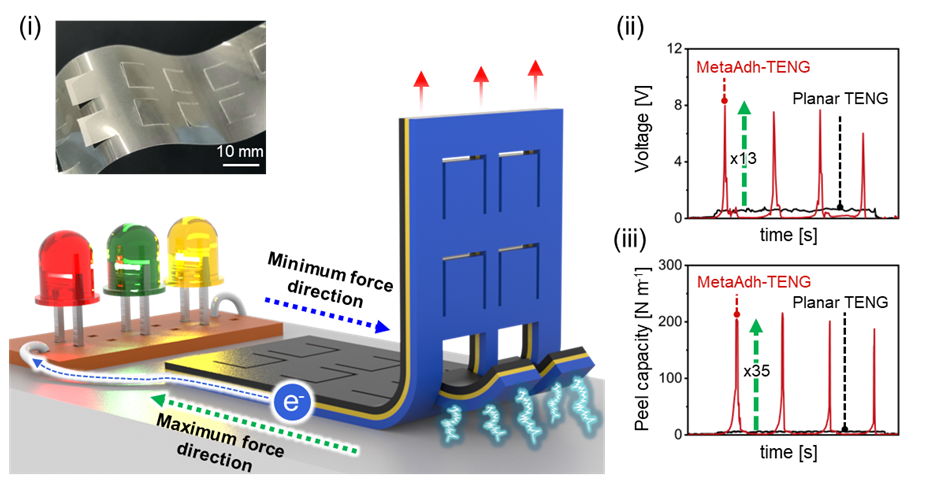Abstract
A new ultra-thin, transparent film, developed by researchers at UNIST can generate electrical signals solely through mechanical peeling or pressing actions. This technology paves the way for smart sensors that operate without batteries, with potential applications in safety, security, and industrial monitoring.
The film leverages the principle of frictional electricity-where charge transfers occur when two materials contact and then separate-to produce electrical signals during routine mechanical movements. By integrating carefully designed cut patterns into an adhesive film, Professor Hoon Eui Jeong and his research team in the Department of Mechanical Engineering at UNIST has created a self-powered sensor capable of converting mechanical stimuli into detectable electrical outputs, while also controlling adhesion strength.
 Figure 1. A schematic image, illustrating the structure and working mechanisms of a metamaterial adhesive-integrated triboelectric nanogenerator (MetaAdh-TENG), which integrates nonlinear cuts and a TENG into a flexible adhesive film.
Figure 1. A schematic image, illustrating the structure and working mechanisms of a metamaterial adhesive-integrated triboelectric nanogenerator (MetaAdh-TENG), which integrates nonlinear cuts and a TENG into a flexible adhesive film.
Featuring a pattern of cuts shaped like the Korean alphabet 'ㄷ,' the film achieves over 35 times higher adhesion and roughly 13 times greater electrical output compared to conventional designs. This allows it to generate strong electrical signals from simple, short actions like pressing or peeling.
Hee Jin Lee, the first author of the study, explained, "The specific cut pattern guides crack propagation, enabling rapid and controlled separation that maximizes electrical output." He further noted, "When a crack halts at a junction and then resumes moving in the opposite direction, it produces a significant electrical signal."
Moreover, by tuning the orientation and arrangement of the cut patterns, the film's electrical and adhesive responses can be customized based on the direction or location of peeling-adding a programmable dimension to its functionality.
The researchers demonstrated practical applications, such as attaching the film to a door frame to generate a signal upon opening, which can activate a warning system. They also developed a system that detects the peeling of a picture frame before it falls, sending alerts to smartphones. Additionally, when applied to a conveyor belt, the film only generates signals during reverse rotation, enabling early detection of abnormal machinery operation and automated shutdowns.
Professor Jeong stated, "This technology transforms a simple adhesive film into a smart, self-generating sensor that requires no batteries." He further added, "Its versatility makes it suitable for various fields, including wearable sensors, theft prevention, and industrial safety systems."
The study was published in Advanced Functional Materials on June 11, 2025, with support from the National Research Foundation of Korea and the Ministry of Science and ICT (MSIT).
Journal Reference
Hee Jin Lee, Dong Kwan Kang, Junghwa Kang, et al., "Metamaterial Adhesives-Integrated Triboelectric Nanogenerators with Enhanced and Programmable Charge Generation and Adhesion," Adv. Funct. Mater., (2025).






